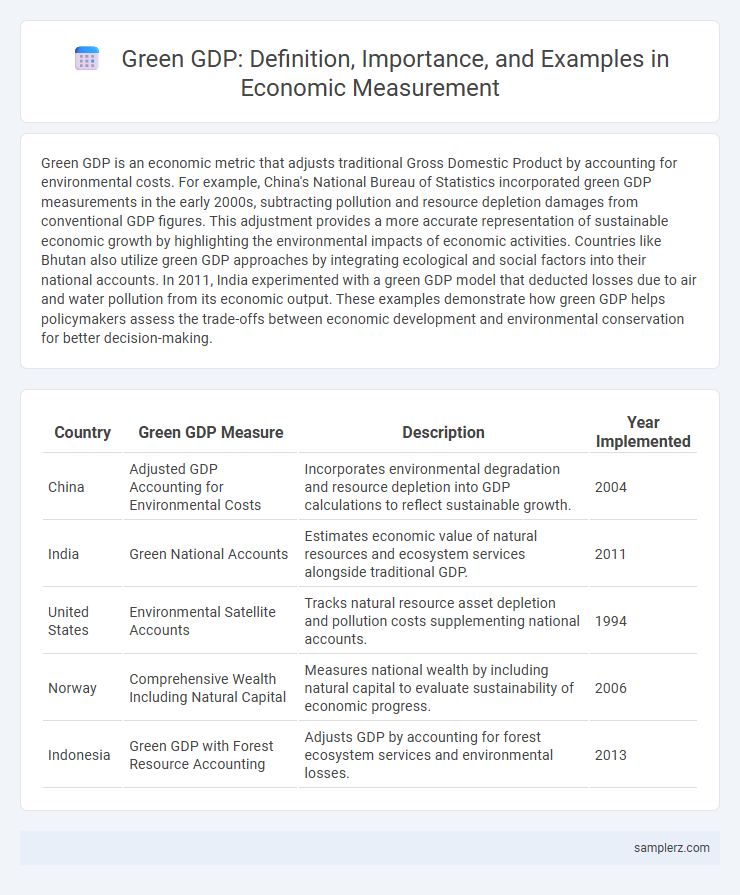Green GDP is an economic metric that adjusts traditional Gross Domestic Product by accounting for environmental costs. For example, China's National Bureau of Statistics incorporated green GDP measurements in the early 2000s, subtracting pollution and resource depletion damages from conventional GDP figures. This adjustment provides a more accurate representation of sustainable economic growth by highlighting the environmental impacts of economic activities. Countries like Bhutan also utilize green GDP approaches by integrating ecological and social factors into their national accounts. In 2011, India experimented with a green GDP model that deducted losses due to air and water pollution from its economic output. These examples demonstrate how green GDP helps policymakers assess the trade-offs between economic development and environmental conservation for better decision-making.
Table of Comparison
| Country | Green GDP Measure | Description | Year Implemented |
|---|---|---|---|
| China | Adjusted GDP Accounting for Environmental Costs | Incorporates environmental degradation and resource depletion into GDP calculations to reflect sustainable growth. | 2004 |
| India | Green National Accounts | Estimates economic value of natural resources and ecosystem services alongside traditional GDP. | 2011 |
| United States | Environmental Satellite Accounts | Tracks natural resource asset depletion and pollution costs supplementing national accounts. | 1994 |
| Norway | Comprehensive Wealth Including Natural Capital | Measures national wealth by including natural capital to evaluate sustainability of economic progress. | 2006 |
| Indonesia | Green GDP with Forest Resource Accounting | Adjusts GDP by accounting for forest ecosystem services and environmental losses. | 2013 |
Introduction to Green GDP in Economic Measurement
Green GDP integrates environmental health into traditional economic metrics by accounting for natural resource depletion and pollution costs alongside conventional output. This measurement reflects sustainable economic performance by subtracting environmental degradation and resource consumption from gross domestic product figures. Implementing Green GDP guides policymakers in balancing economic growth with ecological preservation, promoting long-term environmental and economic stability.
Methodologies for Calculating Green GDP
Methodologies for calculating Green GDP often integrate environmental costs into traditional economic accounting by subtracting the monetary value of natural resource depletion and environmental degradation from standard GDP figures. Common approaches include the System of Environmental-Economic Accounting (SEEA), which quantifies ecosystem services and pollution impacts, and the Genuine Progress Indicator (GPI), which adjusts economic activity by factoring in social and environmental costs. These methodologies enable policymakers to assess sustainable economic growth by reflecting both economic output and environmental health.
Key Indicators Included in Green GDP Assessment
Green GDP assessment incorporates key indicators such as carbon emissions, deforestation rates, and resource depletion to evaluate sustainable economic performance. It adjusts traditional GDP by subtracting environmental costs and accounting for natural capital depreciation. This approach highlights the economic impact of pollution, biodiversity loss, and ecosystem services degradation in national accounting.
Case Study: Green GDP Implementation in China
China's green GDP initiative integrates environmental costs into traditional economic calculations by quantifying resource depletion and pollution impacts. In pilot regions, incorporating air and water pollution damage into GDP assessments reduced reported growth rates but provided a more accurate measure of sustainable development. This approach has influenced national policies to balance economic expansion with environmental preservation, driving investments in renewable energy and pollution control.
Comparison Between Traditional GDP and Green GDP
Traditional GDP measures economic output based solely on market transactions without accounting for environmental degradation or resource depletion, often leading to an overestimation of true economic progress. Green GDP adjusts this by subtracting the economic costs of environmental damage and resource usage, providing a more accurate representation of sustainable growth. Countries like China have implemented Green GDP to highlight the trade-offs between industrial expansion and ecological preservation, revealing lower growth rates compared to traditional GDP figures.
Impact of Environmental Degradation on National Accounts
Green GDP integrates the cost of environmental degradation and resource depletion into traditional GDP calculations to reflect sustainable economic performance. For example, China's green GDP accounting in the early 2000s adjusted its national accounts by subtracting the estimated economic losses from pollution and deforestation, highlighting the true impact on long-term growth. This approach enables policymakers to balance economic development with environmental preservation by quantifying ecological damage in monetary terms.
Role of Natural Resource Accounting in Green GDP
Natural Resource Accounting plays a critical role in measuring Green GDP by integrating the valuation of natural capital depletion and environmental degradation into economic indicators. Through systematic tracking of forest depletion, mineral extraction, and water usage, this method adjusts traditional GDP figures to reflect the sustainable use of resources. Countries like Indonesia and Costa Rica have implemented natural resource accounts to provide more accurate assessments of their economic progress while preserving ecological health.
Global Examples of Green GDP Adoption
China's implementation of green GDP metrics integrates environmental costs into economic growth calculations, influencing policy to reduce pollution and promote sustainability. India has adopted a green accounting system to incorporate natural resource depletion and environmental degradation into its national statistics. Sweden applies green GDP to evaluate the environmental impact of industrial activities, guiding investments in renewable energy and eco-friendly technologies.
Challenges in Green GDP Measurement and Reporting
Measuring green GDP faces significant challenges due to the lack of standardized methodologies and difficulties in quantifying environmental degradation and resource depletion accurately. Data inconsistencies and limited availability of environmental indicators hinder comprehensive reporting and comparative analysis across countries. Integrating ecological and economic data remains complex, often resulting in underestimation of environmental costs and overestimation of economic growth.
Future Trends in Green GDP Integration
Governments and organizations increasingly adopt green GDP metrics that incorporate environmental costs, such as carbon emissions and resource depletion, to better reflect sustainable economic growth. Advanced data analytics and satellite monitoring enhance accuracy in measuring ecosystem services and pollution, driving more informed policy decisions. Future trends indicate widespread integration of green accounting frameworks into national statistics, promoting transparency and incentivizing investments in renewable energy and circular economy practices.

example of green GDP in measurement Infographic
 samplerz.com
samplerz.com